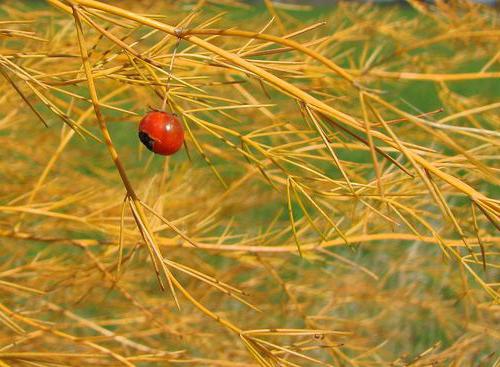These elegant plants, reminiscent of aerial lace, were often found in homes, apartments and offices. Today, this beautiful flower that improves the microclimate and relieves fatigue and stress is much less common. Many beginner growers, despite the efforts made to care, face the fact that asparagus turns yellow and crumbles. What happened and how to fix the situation? In this article we will try to understand the features of asparagus and find out what actions should be taken.
Botanical characteristics
The plants grown in homes and offices are actually close relatives of asparagus, which is also a representative of the Asparagus genus (you can see a photo of it on the left). Both of these plants belong to
the Liliaceae family. In this genus, there are more than 300 species of vines, herbaceous shrubs and perennials growing in Europe, India, South America and Australia. The green fluffy twigs with needles, which we consider to be leaves, are actually cladodes - a thickened stem of this plant. Real leaves of asparagus are small scales, from the sinuses of which cladodias grow, performing the functions of foliage. Its dioecious flowers are small and nondescript, in different species collected in bunches or brushes. They form a red fruit after blackening, with 1-3 large black seeds.
Types of Asparagus
The following types of asparagus are grown in a room culture:
- Sprenger (densely flowered);
- pinnate;
- Meyer;
- crescent;
- the thinnest;
- racemose;
- melloid.
Among all these species, the most common in our indoor floriculture are Sprenger asparagus and cirrus. This is due to the fact that they are easier than other types to tolerate the increased air dryness inherent in our apartments and houses in the winter.
Indoor Asparagus
In room culture, the most common is the asparagus of Sprenger who came to us from the humid subtropical forests of South America . This plant has long shoots on which phyllocladies (leaf stems) are located in the form of needles. This species blooms in late spring - early summer with small fragrant flowers.
Cirrus asparagus, very popular in the 60s and 70s, with lignified curly or erect shoots, on which thin dark green cladodes are located, is rarely seen in homes today.
Asparagus Meyer - the decorative form of this plant, the spindle-shaped stems of which are covered with leaflets arranged by a rosette, is very rare in collections of flower growers. Variegated and undersized forms of densely flowered asparagus are no less decorative and undemanding to care for, but you can find them only with enthusiastic collectors.
Features of winter maintenance and care
Asparagus, the photo of which you see, refers to the appearance of Sprenger and does not require any special care, but still some nuances must be taken into account. The most difficult period is the heating season.
In winter, it is desirable to keep the plant at a low temperature, in the range of +12 ° ... +15 ° . Watering should be reduced, but the soil should not be too dry. In the event that the room temperature rises, the asparagus turns yellow and crumbles. You should not panic, it is enough to trim dry bare stems and reduce watering. At the end of winter and the beginning of spring, new phyllocladies will appear in the plant and it will again acquire a presentable appearance. Since the advent of new shoots, watering the flower should be increased.
What to do in the summer?
With the onset of steady warm weather, asparagus can be sent to the garden for fresh air or simply moved to the balcony. In spring and summer, the plant needs to be fed with mineral fertilizers, best of all complex, once every two weeks. It happens that asparagus turns yellow and crumbles in the summer. The problem may be that the root system of this plant develops very quickly and the pot becomes small. Young flowers require a transplant annually, but for three-year-old and older plants - every two to three years.

An overgrown root system must be carefully trimmed and removed bare branches to provide an incentive for the growth of new ones. In winter and summer with low humidity in the room, the plant should be sprayed. In addition, if asparagus crumbles in the summer, then it is possible that he received a sunburn. It is important to remember that direct sunlight can withstand only one species - Sprenger asparagus. All other asparagus love good, but diffuse lighting. If your plant was burnt by the sun, then just move it to partial shade.
The reasons for yellowing
Thus, the answer to the question of why asparagus turns yellow and crumbles is one - a violation of the cultivation technique. Violations include:
- lack of light and moisture;
- excess watering;
- excessive lighting;
- too dry air.
By eliminating the causes that caused yellowing and shedding, you can save the plant, which, if you create the necessary conditions for it, will delight you with its lush greenery.